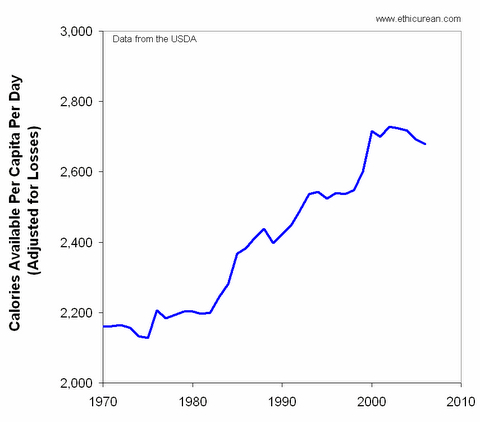By Ryan Andrews
What is energy balance?
“Energy balance” is the relationship between “energy in” (food calories taken into the body through food and drink) and “energy out” (calories being used in the body for our daily energy requirements).
This relationship, which is defined by the laws of thermodynamics, dictates whether weight is lost, gained, or remains the same.
According to these laws, energy is never really created and it’s never really destroyed. Rather, energy is transferred between entities.
We convert potential energy that’s stored within our food (measured in Calories or kcals) into three major “destinations”: work, heat and storage.
As the image below shows, the average number of available calories per person in the US is increasing. In general, there is more “energy in”.
When it comes to “energy out,” the body’s energy needs include the amount of energy required for maintenance at rest, physical activity and movement, and for food digestion, absorption, and transport. We can estimate our energy needs by measuring the amount of oxygen we consume. We eat, we digest, we absorb, we circulate, we store, we transfer energy, we burn the energy, and then we repeat.
How to Be Negative or Positive
- Build muscle with weight training (about 5 hours of total exercise each
week) and proper nutrition - Create muscle damage with intense weight training
- Maximize post workout energy expenditure by using high intensity exercise
- Regular program change to force new stimuli and adaptations
- Boost non-exercise physical activity
- Increase thermic effect of feeding by increasing unprocessed food intake
- Eat at regular intervals throughout the day
- Eat lean protein at regular intervals throughout the day
- Eat vegetables and/or fruit at regular intervals
- Incorporate omega-3 fats
- Incorporate multiple exercise modes
- Stay involved with “life” outside of exercise and nutrition
- Sleep 7-9 hours each night
- Don’t engage in extreme diets for risk of long-term overcompensation
- Stay consistent with habits
- Ignore food advertising
- Build muscle with weight training (at least 4 hours of intense exercise per week) and proper nutrition
- Create muscle damage with intense weight training
- Minimize other forms of exercise (other than high intensity and resistance training)
- Limit excessive non-exercise physical activity
- Try consuming more shakes and liquids with calories
- Build in energy dense foods that don’t cause rapid satiety (nut butters, nuts, trail mix, oils, etc.)
- Eat at regular intervals throughout the day
- Incorporate additional omega-3 fats
- Take advantage of peri-workout nutrition, with plenty of nutrients consumed before, during, and after exercise
- Sleep 7-9 hours per night
- Stay consistent with habits




Speak Your Mind